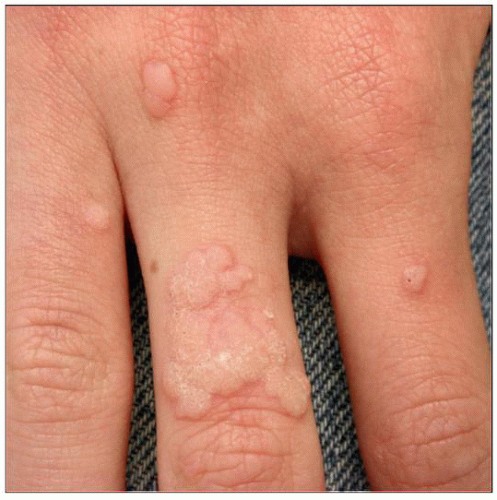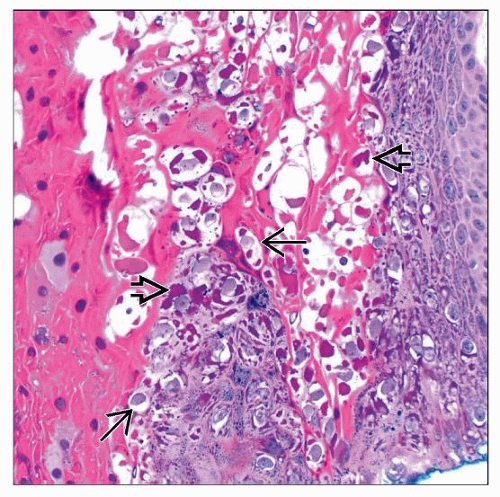Verruca Vulgaris (and Variants)
David Cassarino, MD, PhD
Key Facts
Terminology
Verruca vulgaris (VV)
Common warts
Palmoplantar warts (myrmecia)
Flat warts (verruca plana)
Etiology/Pathogenesis
Causal relationship with numerous HPV types
Clinical Issues
Common sites include fingers and hands (verruca vulgaris), palms and soles (palmoplantar warts), face and dorsal hands (flat warts)
Microscopic Pathology
Exophytic/endophytic papillomatous proliferation with hypergranulosis, dense overlying hyperkeratosis, and tiers of parakeratosis
Intracorneal hemorrhage typically present
Periphery often shows “pointing inward” of the basilar epidermis
Superficial keratinocytes show perinuclear halos and prominent keratohyaline granules
Palmoplantar warts show especially prominent keratohyaline inclusions
Lesions may be irritated and inflamed, often associated with reactive atypia
Top Differential Diagnoses
Verrucous keratosis
Seborrheic keratosis (SK)
Lichen simplex chronicus (LSC)
Hypertrophic lichen planus (LP)
Verrucous carcinoma
Epidermodysplasia verruciformis (EDV)
TERMINOLOGY
Abbreviations
Verruca vulgaris (VV)
Synonyms
Common warts
Variants
Palmoplantar warts (myrmecia)
Flat warts (verruca plana)
Definitions
HPV-related benign epidermal proliferation
ETIOLOGY/PATHOGENESIS
Infectious Agents
Causal relationship established with numerous HPV types, including HPV 1, 2, 3, 4, 7, 10, 27, 29, 57
Most common types include 1, 2, 3, 4, 7, 10
CLINICAL ISSUES
Epidemiology
Incidence
Very common lesions
Age
Common in children and young adults but can occur at any age
Site
Common sites include fingers and dorsal hands (verruca vulgaris), palms and soles (palmoplantar warts), face and dorsal hands (flat warts)
Presentation
Small papular to plaque-like lesions
Natural History
Grow rapidly, then stabilize
Some lesions may regress
Treatment
Surgical approaches
Complete excision is curative but not necessary in most cases
Drugs
Topical therapy with podophyllin or other antiviral medications
Prognosis
Excellent, unless immunosuppressed
Rare cases of cutaneous carcinoma are associated with various HPV types, especially in immunosuppressed patients
MACROSCOPIC FEATURES
General Features
Often exophytic-appearing scaly (hyperkeratotic) lesion
Size
May be small (several mm) papules to large plaques (several cm)
MICROSCOPIC PATHOLOGY
Histologic Features
Exophytic and endophytic papillomatous epidermal proliferation
Epidermal acanthosis with hypergranulosis, dense overlying hyperkeratosis, and tiers of parakeratosis (“church spires”)
Flat warts show acanthosis and hyperkeratosis, but they lack significant papillomatosis and parakeratosis
Intracorneal hemorrhage typically present
Periphery of lesion shows pointing (“toeing”) inward of the basilar epidermis
Superficial keratinocytes may show perinuclear halos and prominent keratohyaline granules
Palmoplantar warts (myrmecia) show especially prominent keratohyaline inclusions, which appear basophilic
Stay updated, free articles. Join our Telegram channel

Full access? Get Clinical Tree






